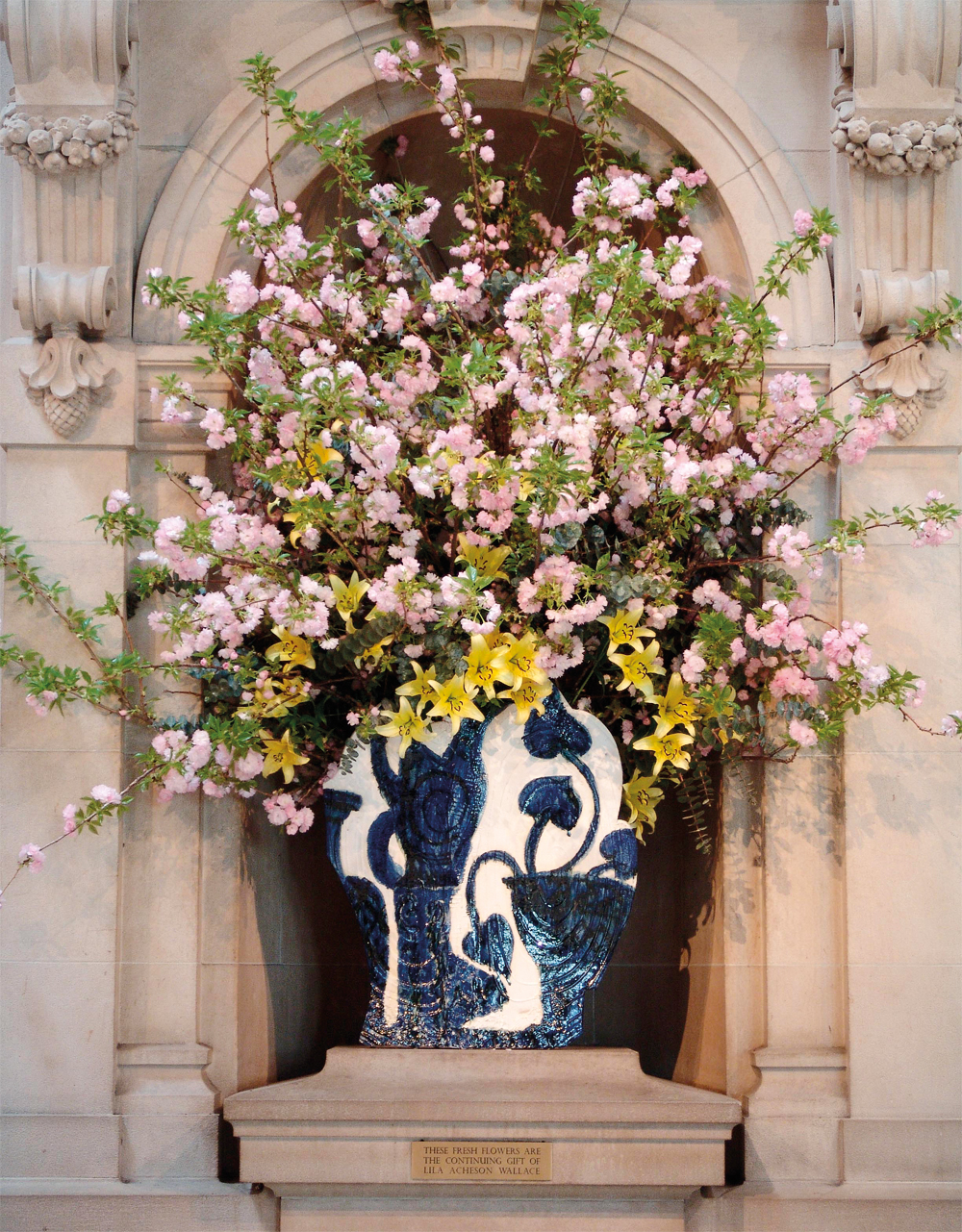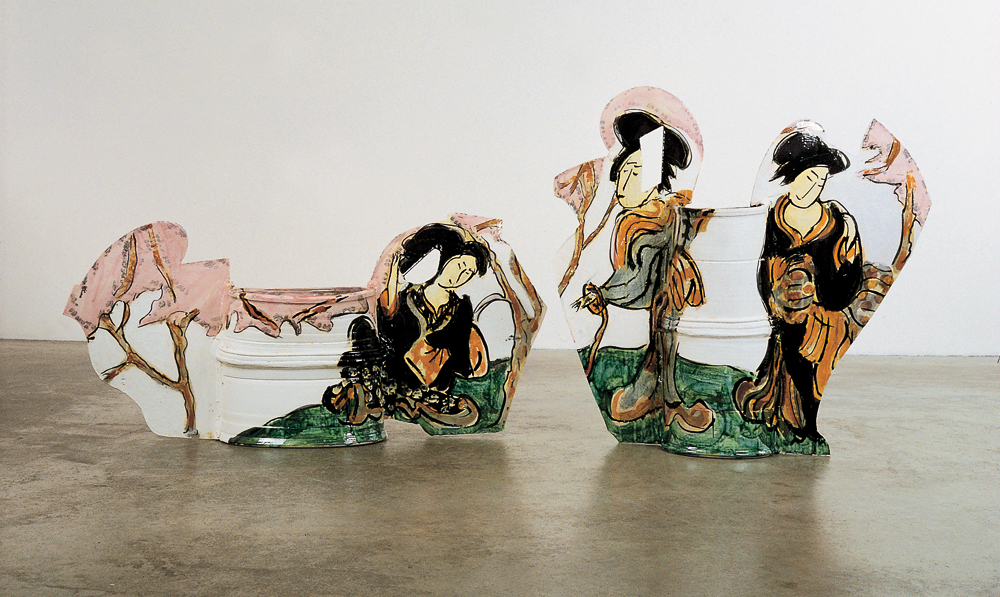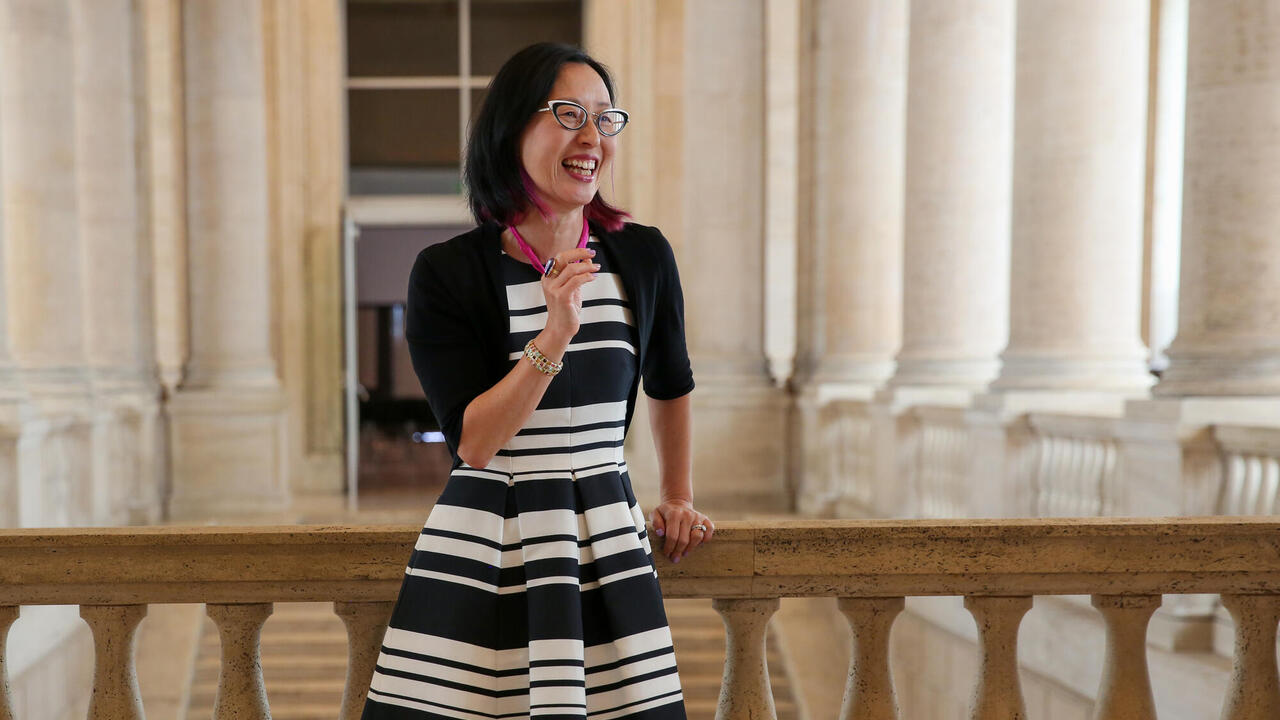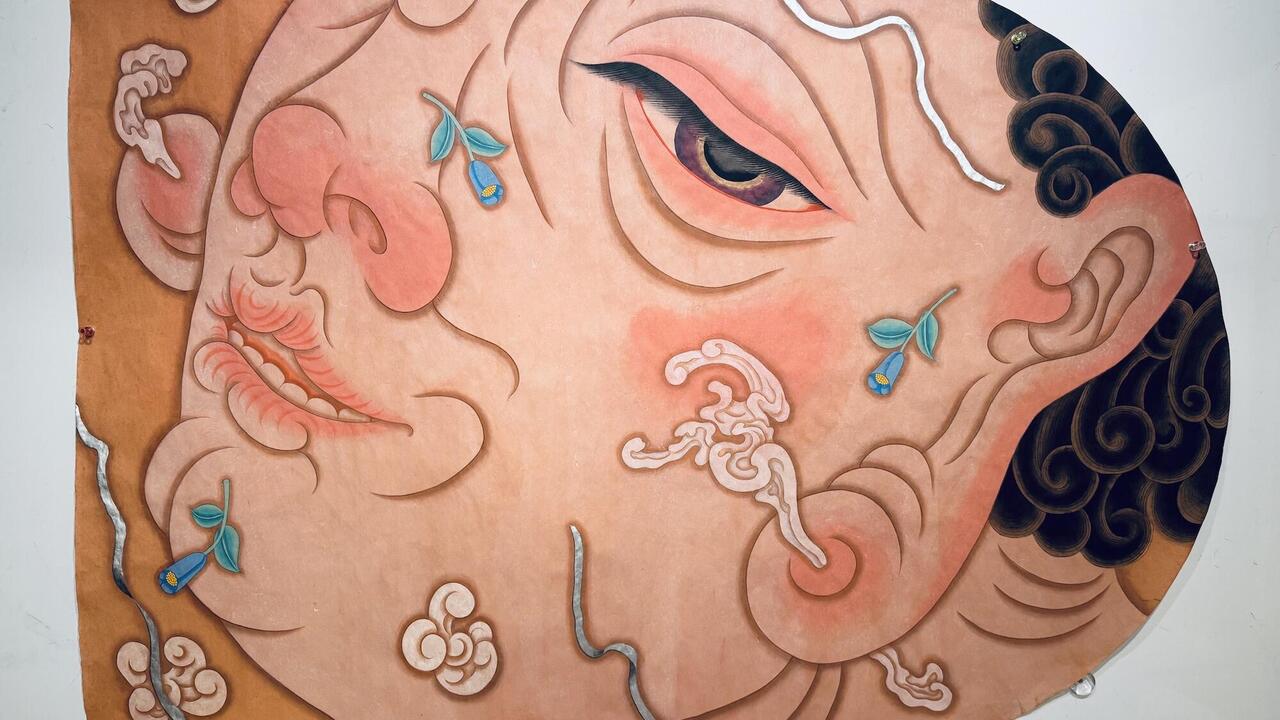Feel More
With the sad news of the passing of Betty Woodman, revisiting her interview where she talked about ceramic histories and modern painting
With the sad news of the passing of Betty Woodman, revisiting her interview where she talked about ceramic histories and modern painting

Chinese translation: ![]() feelmore.pdf
feelmore.pdf
I first learned about Betty Woodman when I was a 20-year-old student researching the photographic self-portraits of her daughter, Francesca. I was haunted by Francesca’s stark, melancholic images and equally fascinated by Betty’s exuberant, colourful and defiantly decorative ceramic objects, which were seductive in an entirely different way. Yet, later, seeking out Betty’s works among the bowls and vases in the ceramics galleries of the Victoria & Albert Museum, it struck me that, despite these differences, both artists were dealing with similar underlying questions about domestic spaces and how to exist with them as a woman.
That was in 2007, a year after the Metropolitan Museum of Art in New York had given Betty, then 76, her first US retrospective – its first ever of a living female artist. Still, my back-to-front route to her work says much about the peripheral status of her chosen medium – clay – in contemporary art as recently as a decade ago. Much has changed since then; if, today, Woodman’s work feels familiar, it is not only the result of her numerous recent solo exhibitions but also by way of the many younger artists whose ceramic practices owe a great debt to hers.
Woodman’s work always begins on the wheel, though it often ends up being flattened, cut out or joined to other pieces, stacked or squashed together. Her extensive knowledge of ceramic technique and tradition – from which she borrows ceaselessly, reinterpreting and recombining – is clear, as is her longstanding interest in the social histories of the cups and plates, bowls and pitchers that we use every day and which have been with us since the very earliest civilizations. For almost seven decades, Woodman has experimented with the vessel form – adding to it, fragmenting it, pushing it beyond function and almost beyond recognition. Some of her pieces are like sketches for imagined pots – all Crayola-box colours and decorative flourishes – magically taken shape. As critic Peter Schjeldahl has noted, Woodman doesn’t make pots that invite touching. Her works are frontal: painted surfaces as much as three-dimensional forms.

Betty and her husband, the painter and photographer George Woodman (who decorated her early pots, until she took over, in around 1970), divide their time between New York and Antella, a small town in the hills outside Florence, Italy.
Woodman visited London in October; we met near Regent’s Park on a crisp autumn morning to talk about the evolution of her work and her upcoming projects.
Amy SherlockTell me how you started out.
Betty Woodman I took a class in ceramics at high school. It was a period when, if you were teaching and you did a summer course, you got paid a little more money; it was sort of required to bolster your position in the public school system. My teacher had gone to Cranbrook Academy in Michigan and taken a course with Maija Grotell, who was a big figure in the history of American ceramics. This teacher talked the school into letting her teach a pottery class in a room in the attic.
At that moment [around the 1940s], pottery still saw itself as responding to industrialization; the ideals of the art and crafts movement and the writings of people like Herbert Read were in the air. When I was starting out, I was intent on being a potter and making functional things. I had all these ideas about improving society; a philosophy that if people had beautiful, handmade objects, it would somehow make them better, make life better and so on. And I still believe it. I think if you are drinking your coffee out of a nice cup, it’s a more intimate and meaningful relationship than with a Styrofoam mug.
AS When did you move away from making vessels and functional objects?
BW My first trip to Italy in 1951 was very important. At that time in the US, there was a dominant aesthetic in ceramics that had come by way of Bernard Leach and Shōji Hamada, which was about an idealization of English folk art and traditional Oriental techniques, a synthesis of the two. In fact, Leach’s book [A Potter’s Book, 1940] was really the only one we had, and we all read it as if it were the Bible.
But, in Italy, I became aware of a whole other world of ceramics that I had no idea about. It wasn’t brown and it wasn’t functional. There was a sort of moral dimension to Leach’s pottery, and to the aspirations of Standard Ware. It was supposed to be about simplicity and humility: a humble potter and a humble pot.
AS Yes, and that was the contradiction of Leach, around whom there was a real personality cult and who was quite dictatorial about what ceramics could and should be.
BW He came to teach at Alfred University for a couple of weeks in the 1950s.
'I taught for many years and realized that everybody thinks they understand clay; everybody thinks it's easy to work with.'
AS Did you do any classes with him?
BW No, he came to the New York State College of Ceramics at Alfred: they were training ceramic designers and their graduate programme had people who were interested in making art. I went to the School for American Craftsmen, across the street.
From the mid-1940s, the GI Bill [1944 Servicemen’s Readjustment Act], allowed men returning from the war to study without having to pay for it, which meant you had all kinds of people able to go to college that couldn’t before. College art departments expanded and there started to be ceramic departments.
Our school was an experimental school [established by the philanthropist Aileen Osborn Webb, founder of the American Craft Council, in 1944], which was set up to teach people to be craftsmen. You didn’t get a degree; you worked with either clay, fibre, metal or wood for two years – it was kind of an apprenticeship system.
AS What did you find in Italy?
BW At first, I was just overwhelmed by the Etruscan pots. I was amazed by the shape of them, particularly the way the handles extend the forms. Because they are earthenware fired at a low temperature, you could get away with a grand gesture like that, which is very hard to do. I think to try to make this kind of extended handle would be brutal and unpleasant – if not impossible – in stoneware.
AS Have you always worked with earthenware?
BW No. I’ve worked with everything. That’s one of the riches of clay: there are so many kinds. You can go from earthenware to stoneware to porcelain … Each of the materials, in my hands, dictates what I can do, to an extent. I am interested in making something that takes the material as far as it can go, without being impossible.
I think it’s important that the work doesn’t seem labour-intensive; it may be, but I’m not really interested in people looking at my pieces and saying: ‘Oh! How did she do that?’
AS Sometimes that can be a distraction. What about with something like the ‘pillow pitcher’, which is one of your most recognizable forms? Its shape is very unusual: there is definitely an element of: ‘How is this made?’
BW I gave up making the pillow pitcher a long time ago precisely because it was so recognizable. It originally came about because I was making some large pieces, which were two hanging flower pots put together horizontally. These were dubbed the ‘Erotic Burrito’ series (1971–75). The pillow pitcher evolved out of that – it grew larger and wider and I added the handle and spout. I was – I am – very interested in the pitcher. It seems to me that, in the Western world, the pitcher is the archetypal ceramic object. The pillow pitcher became a vehicle for acknowledging that long history, as well as a surface upon which I could explore my interest in painting.

AS There’s something comforting about the pillow pitcher. It’s almost a maternal form.
BW I think clay is like that: it’s a material that doesn’t put you off. It’s interesting: I taught for many years and realized that everybody thinks they understand clay; everybody thinks it’s easy to work with. I believe this is because it’s so much a part of everybody’s life – everyone has plates and coffee cups, which is perhaps also one of the reasons that, for such a long time, it wasn’t accepted as a ‘high’ art material.
AS Have you ever considered your work to be feminist, in terms of its engagement with domestic objects and ‘low’ or ‘craft’ materials?
BW I was making work in the late 1960s and ’70s, when the first wave of feminist art was around. Lucy Lippard taught in Colorado, where my husband was
also teaching, and we all had our consciousnesses raised.
I could make arguments for myself as a feminist, for example, in terms of my relationship to function. Functional, to me, as a woman, meant nurturing, nourishing and so on – a relationship to food, which was very much related to my work in ceramics.
But, at that time in America, the world of ceramics, where it intersected with ‘high art’, was totally dominated by the macho, and you had to be one of the boys in order to be accepted.
AS I’m thinking particularly of the west-coast scene centred around Pete Voulkos and the people that came out of his programme at Otis College of Art and Design in the 1950s and ’60s. For many of them it seemed to be about wrestling with the material.
BW My attitude was that it’s not about wrestling. It’s like bricks: you take a small piece and put another on top, then another, and you come up with a building.
I knew some of those guys – not well, mostly, but I was very friendly with Paul Soldner [Voulkos’s first student in the ceramics programme at Otis], who died a few years ago. I owe a great deal to Paul because, in the late 1960s, when he built a house in Aspen, Colorado, I invited him to Boulder, where I was working. He was interested in what I was doing, so he asked me to participate in the Scripps Annual in Claremont, California, in 1968.
The show at Scripps gave me more visibility and, a few years on, when Ken Ferguson was curating ‘Eight Professional Potters’ at the Kansas City Art Institute in 1976, he approached me. This was at a moment when everyone was very aware of the lack of visibility of female artists, largely thanks to the feminist movement. Suddenly, it was like: ‘We have to have a woman in the show,’ so I was invited.
AS You were the only woman in the show?
BW I was one of two women in the show. Which was fine. I hope people didn’t just see me as a token woman and that they actually looked at what I was doing. But then, who knows?
AS Was there a point where you thought: ‘I am an artist. I’m no longer a potter.’
BW Yes. I think it was probably about 30 years ago that I realized that I wanted my work to be seen outside of a ceramics context – around the time that I started to show with Max Protetch in New York, which was in 1983.
At that time, Max was also working with Scott Burton, who encouraged me. He was making sculpture that was furniture – or the other way around. It was about functional and art objects not necessarily being in opposition. For instance, he made those chairs outside the AXA Equitable building in New York, which are still used: people sit on them every day. In the same way, I think that some of the confusion of my work has been that I move back and forth between the actual object and something else. Both Scott and I were interested in making forms that were domestic, but situating them outside of that context.

From my own point of view, I feel as though I am sort of a cross-dresser, and it confuses people. For many years, I have considered myself to be an artist among other artists: I have my material and you have yours. I wouldn’t call myself ‘conceptual’; on the other hand, I have a few ideas in my head.
I’m also very interested in painting; I have been looking at painting for a long time. You know, I live with a painter – my husband George – and our lives have always been very involved with those of other artists, so this is what the conversations are about. When you look at a painting – by Barnett Newman or whoever – you realize that black isn’t just there; it’s what’s underneath that is affecting it. I wanted to make works that were visually rich; I wanted people to look at them as they would a painting.
AS It seems to me that you often take a vessel and you attach surfaces to it to form a kind of canvas: the ceramic form becomes a support for the painted plane.
BW Obviously I continue to use the vessel and, in a sense, that’s the subject matter of my work. But I am interested in taking it someplace else.
Over the past few years, I have also been making actual paintings on canvas and, by themselves, I think they look perhaps not very good or dated or they reference Pierre Bonnard, or whoever I am interested in, too closely. But the addition of the ceramics changes the way you see the painting; it gives it a different reading.
AS When I look at your work, I also see that you are referencing many historical craft traditions: Japanese Oribe glazes, American slipware, Meissen rococo flourishes and so on.
'For many years, I have considered myself to be an artist among other artists. I wouldn't call myself 'conceptual'; on the other hand, I have a few ideas in my head.'
BW I don’t think anything I make is simple. I hope there’s enough in the work that, if you continue to look at it, you read it in new ways.
The new piece for the ICA show is made up of four canvases – it’s nearly nine-and-a-half metres long – which will run along one wall. It’s called Summer House and it depicts a domestic interior, in sections. There is a painting of a table and, at the bottom, a wooden structure that juts out, so it looks as though it’s coming out of the surface. And, on the shelves, there are some actual vases, which somewhat recall the painted objects on the table behind. I am playing with perspective and with the movement between two- and three-dimensionality. The works in my show at Salon 94 earlier this year – ‘Breakfast at the Seashore Lunch in Antella’ – are all dealing with these ideas, too.
AS And illusion? In a way, Summer House is a return to much earlier pieces such as Aspen Garden Room [1983]. You create the illusion of a space with objects – columns, frames – that suggest an architecture, but which aren’t quite functional.
BW It’s also about the illusion of scale. It’s not really architecture: it’s alluding to that, it’s about that, but it’s smaller than reality.
AS Yes, with Aspen Garden Room I felt that particularly acutely because I’m tall and I had to really stoop to get in there.
BW Exactly, stooping is part of it. I didn’t want it to be a real room that you could inhabit, but an array of different elements – materials and forms – that suggest how a room is constructed.
AS It reminds me of Livia’s Garden Room at Palazzo Massimo in Rome – a beautiful, whole-room fresco of a garden scene that they found while they were excavating the villa of Emperor Augustus’s wife, Livia, just outside the city. There are certain trompe l’oeil details, like a little fence and a garden wall; you feel as though you could be outside although the room was actually subterranean.
BW It’s an amazing museum, isn’t it? And nobody’s ever been; it’s perfect! I can get off the train and walk right over there, or stop for a visit before I take the train home to Florence.
But the point about rooms … Well, I have my whole theory about playing house. In some ways, I think that’s what making pottery is all about. I’ve made work at the Sèvres factory, just outside of Paris, on and off since 1986, and all of that exquisite porcelain seems like a game, a way of pretending to be a princess – as though you, too, could be Marie Antoinette or someone like that. With Summer House or Aspen Garden Room, it’s a similar kind of illusion: it’s not the space you live in, but it’s a space you might imagine.
AS Or daydream?
BW Yes.
AS There’s a wonderful Gaston Bachelard quote from The Poetics of Space [1958], where he says the primary function of the house, of all houses, is to shelter the daydreamer. I think it’s true: the home is a projected space as much as it is a concrete one. I think your pots belong to daydreams, in a sense: they mesh objects and illusions with different historical spaces and cultural traditions.
BW At this point, there’s a lot of art around that seems really intent on making you feel bad; perhaps aiming to raise your consciousness of all the evil in the world in the hope that you’ll do something about it. I don’t think that’s what I am doing. I’m trying to make you feel more, and to make something that I get pleasure out of seeing.
AS You believe in beauty?

BW Oh, yeah, I’m afraid I do! Not only that, but both George and I are visual artists: we really believe in looking at art. And I think that’s become unfashionable. There’s so much art being made that really has nothing to do with looking: it’s about reading. Which is all very well …
AS Who or what have been your biggest influences?
BW Well, this whole business of the table, which I’ve been obsessed with for a couple of years, came from Bonnard, particularly the paintings that he made from his breakfast room looking out into the garden. Often, in his paintings, there’s an interior with a window and you look through it, you look beyond. That has been with me for a long time.
AS What about Henri Matisse? Your wallpaper works and balustrade vases make me think of his cut-out pieces.
BW You know, I think for many years I tried to stay away from Matisse, because I felt it was too much. I had too many people look at my pieces and say: ‘Oh, yeah, Matisse.’ But, obviously, his work has been a great joy to me.
AS I was thinking more in relation to your point about not wanting your work to feel laboured. The cut pieces have an amazing ease and fluidity.
BW Absolutely. And, you know, as you learn about Matisse, it didn’t come easily to him at all. It was a lot of trying and things not working and trying again. But the look of it is peaceful.
AS How do you feel about the re-emergence of clay as a medium amongst young artists at this point in time? And the currency that the decorative, more broadly speaking, now has within the art world?
BW Clay has certainly become an acceptable material to make art with, but it seems as though it’s important for people – for artists – to say: ‘I don’t know anything about this, but I am doing it.’ And, it’s a little frustrating, you know, because why don’t you know anything about it? You could do something about that. But, in order to be accepted in the art world, it seems necessary to ...
AS Deny the craft?
BW ... know nothing. And that kind of work is not very interesting.
AS Did you ever see yourself as rebelling against something?
BW No, I don’t think so. I think I’ve always believed in what I am doing and I’ve been very firm about it – aggressive about it, in a way.
I’m 85 and part of the current interest in my work is because, suddenly, clay is acceptable; but the other thing is that the art world is now interested in older artists who have perhaps been overlooked.
There are lots of things I’d still like to do, but, you know, I’m pretty fortunate.
Betty Woodman’s solo exhibition, ‘Theatre of the Domestic’, curated by Vincenzo de Bellis, is at ICA, London, until 10 April. A version of the show was on view at the Museo Marino Marini, Florence, Italy, in late 2015, and a catalogue will be published this spring. She is also included in the Liverpool Biennial 2016, UK, which opens in July. Earlier this year, she had a solo show at Salon 94, New York, USA, and she recently had solo exhibitions at David Kordansky Gallery, Los Angeles, USA, Mendes Wood DM, São Paolo, Brazil (both 2015), Galerie Francesca Pia, Zurich, Switzerland (2014), and Galerie Isabella Bortolozzi, Berlin, Germany (2013).























